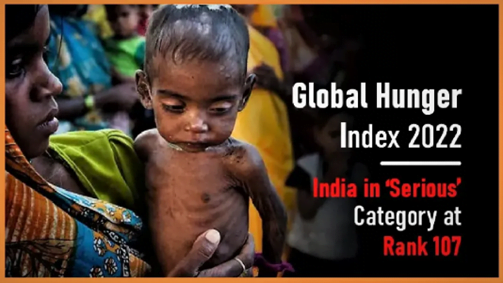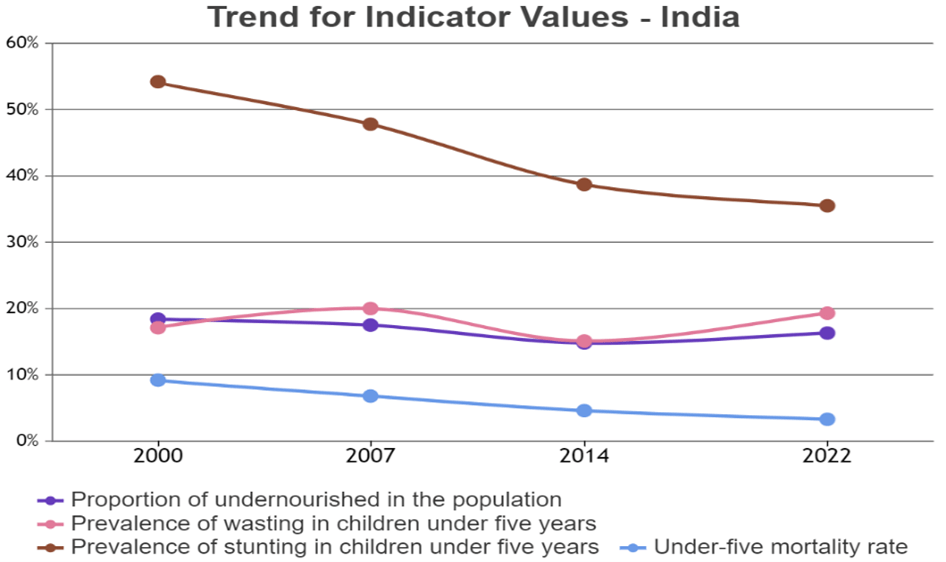Governance
Context: The Global Hunger Index (GHI) 2022 has brought more unwelcome news for India, as far as its global ranking on a vital indicator of human development is concerned. India ranked 107 out of 121 countries.
- The Government of India attempted to discredit the index immediately in its attempt to deny the findings of the report, even going so far as to term it a conspiracy against India.
About Malnutrition:
- It refers to deficiencies, excesses or imbalances in a person’s intake of energy and/or nutrients.
- It is a chronic problem and a longstanding challenge for the public administration of India.
- The term malnutrition addresses 3 broad groups of conditions:
- Undernutrition:
- It includes wasting (low weight-for-height), stunting (low height-for-age) and underweight (low weight-for-age)
- Together, the stunted and wasted children are considered to be underweight, indicating a lack of proper nutritional intake and inadequate care post-childbirth.
- Micronutrient-related malnutrition:
- It includes micronutrient deficiencies (a lack of important vitamins and minerals) or micronutrient excess; and
- Overweight:
- It includes obesity and diet-related noncommunicable diseases (such as heart disease, stroke, diabetes and some cancers).
About Global Hunger Index:

- The GHI is an important indicator of nutrition, particularly among children, as it looks at 4 factors:
- Child stunting
- Child wasting
- Child mortality
- Undernutrition (calorific deficiency) across the population.
- GHI is a tool for comprehensively measuring and tracking hunger at global, regional, and national levels.
- It is an annual by European NGOs of Concern Worldwide and Welthungerhilfe.
India’s performance in GHI 2022:
- India has a score of 29.1 which places it under ‘serious’ category.
- Among the South Asian countries, India (107) is ranked below Sri Lanka (64), Nepal (81), Bangladesh (84), and Pakistan (99). Afghanistan (109) is the only country in South Asia that performs worse than India on the index.

Issues with addressing the problem of malnutrition:
Manpower constraints:
- Over 50% Child Development Project Officer (CDPO) posts were vacant in Jharkhand, Assam, Uttar Pradesh, and Rajasthan, pointing to severe manpower constraints in successfully implementing the scheme of such importance.
No routine in social audits:
- Social audits that are meant to allow for community oversight of the quality of services provided in schools are not carried out routinely.
Inadequate funding & implementation:
- Gaps remain in how the already existing centrally-sponsored schemes are funded and implemented.
- The budgets being allocated are nowhere near the scale of the funds that are required to improve nutrition in the country.
- For example, the Saksham Anganwadi and Prime Minister’s Overarching Scheme for Holistic Nutrition (POSHAN) 2.0 scheme (which now includes the Integrated Child Development Services (ICDS) scheme), which seeks to work with adolescent girls, pregnant women, nursing mothers and children below three.
- However, the budget for this scheme for FY2022-23 was less than 1% more than the actual spend in FY2020-21.
Issues with cash transfers:
- Cash transfers seem to be a favoured solution for several social sector interventions in India today, and this includes the health and nutrition sectors.
- But evidence of the impact of cash transfer on child nutrition in India is limited so far.
- The effect of cash transfers is also limited in a context where food prices are volatile and inflation depletes the value of cash.
Social Factors:
- Equally, there are social factors such as ‘son preference’, which sadly continues to be prevalent in India and can influence household-level decisions when responding to the nutrition needs of sons and daughters.
Other factors:
- Malnutrition persists due to depressed economic conditions in large parts of the country, the poor state of agriculture in India, persistent levels of unsafe sanitation practices, etc.
Measures Taken to Tackle Malnutrition:
- Poshan Abhiyan:
- It is a multi-ministerial convergence mission with the vision to ensure the attainment of malnutrition free India by 2022.
- The Ministry of Women and Child Development (MWCD) is implementing POSHAN Abhiyaan.
- Prime Minister’s Overarching Scheme for Holistic Nutrition (POSHAN) 2.0 scheme:
- It now includes the Integrated Child Development Services (ICDS) scheme, which seeks to work with adolescent girls, pregnant women, nursing mothers and children below three.
- Integrated Child Development Services:
- It represents one of the world’s largest and unique programmes for early childhood care and development.
- The beneficiaries under the Scheme are children in the age group of 0-6 years, pregnant women and lactating mothers.
- The Ministry of Women and Child Development is the implementing agency.
- Mid-Day Meal Scheme:
- The Mid-day Meal Scheme is a school meal programme in India designed to better the nutritional standing of school-age children
- It covers all school students studying in Classes 1 to 8 of government schools, government-aided schools, special training centres, including madrasas supported under Samagra Shiksha Abhiyan.
- National Food Security Mission:
- It was launched in 2007-08 by the Ministry of Agriculture and Farmers’ Welfare as a Centrally Sponsored Scheme.
- It focuses on the sustainable increase in the production of targeted crops through area expansion and productivity enhancement.
- National Nutrition Mission:
- It is the government’s flagship programme to improve nutritional outcomes for children, pregnant women and lactating mothers.
- To reduce stunting and wasting by 2 percent per year (total 6 per cent until 2022) among children and anaemia by 3 percent per year (total 9 per cent until 2022) among children, adolescent girls and pregnant women and lactating mothers.
- The Ministry of Women and Child Development is the nodal ministry for implementation.
Suggestions Measures to Improve Malnutrition in India:
- Need of a comprehensive programme:
- A comprehensive programme targeting adolescent girls is required if the intergenerational nature of malnutrition is to be tackled.
- Cash transfers:
- Cash transfers can also be used to incentivise behavioural change in terms of seeking greater institutional support.
- Food rations through PDS and special supplements for the target group of pregnant and lactating mothers, and infants and young children, are essential.
- Fixing the pre-existing schemes:
- Fixing the pre-existing schemes is the obvious answer to addressing India’s multi-dimensional nutrition challenge.
- Getting the already existing schemes right requires greater involvement of local government and local community groups in the design and delivery of tailored nutrition interventions.
- Keeping it a top priority:
- The need of the hour is to make addressing child malnutrition the top priority of the government machinery, and all year around.
Source: The Hindu














